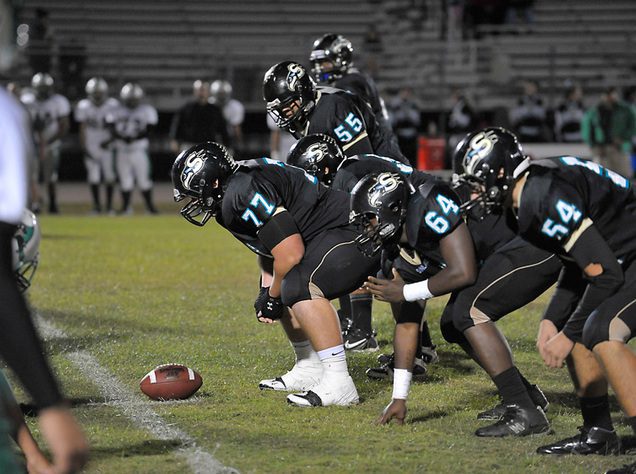As a high school football coach for over thirty years at five different public high schools in three metropolitan areas (Cleveland, Cincinnati, Minneapolis) in two states, there has been one common theme: building a competent offensive line can be very challenging. Although football is the country’s top spectator sport, and more kids play high school football than any other single sport, kids don’t grow up in the back yard blocking people. The fun of football to a youngster is the throwing, catching, or running with the ball. If a kid is really aggressive, he may enjoy tackling, but he’s not running around saying “I want to play offensive guard.”
Additionally, if one has never actually played offensive line, he/she has no idea what it is like to do it. It is physically difficult, in that the lineman is himself moving and attempting to use his strength to move someone (often his same size or larger, and often faster) many plays consecutively. It is mentally difficult, because the lineman must know whom to block, how to block him, and on a variety of different plays and with the defense rarely in the same spot two plays in a row. Potentially most difficult is the emotional challenge – never being allowed to fulfill those desires that were most fun as a youth (playing with the ball itself), receiving much criticism if the offense doesn’t move the ball, and receiving little recognition when the offense does move the ball well.
The offensive line obstacles that teams face in a nutshell are:
1. Potential lack of players with the size to be competent varsity linemen;
2. Potential lack of players with the desire to be competent varsity linemen;
3. Potential lack of effort by the linemen to do the work year round to increase strength, size, and quickness/agility;
4. Potential myriad of other activities that can interfere with the lineman’s ability to improve physically, even if that athlete is motivated to improve;
5. Potential coaches’ lack of understanding of the mind of an offensive lineman, especially if that coach never played offensive line.
6. Potential coaches’ inability to properly instruct, develop, and motivate the offensive linemen.
Of the five high schools where I’ve coached, four were in the division or classification that included the state’s largest schools and suburbs of large cities. I can only imagine how much more difficult the problems are in small schools (with less potential players) or in rural areas (where theoretically it is tougher to build a coaching staff).
However, success for a football team cannot exist without a good offensive line. Fortunately there are solutions to each of the obstacles listed above.
1. Potential Lack of players with the size to be competent varsity linemen:
- A lack of “big enough” linemen can be rectified by utilizing gap blocking schemes and pulling/trapping. Emphasizing quickness of the first step and building size in the weight room are obvious benefits, as well as allowing the linemen to “play fast” by limiting the analysis of blocking assignments each play (keep it simple – “cloudy minds equal slow feet”);
2. Potential lack of players with the desire to be competent offensive linemen:
- creating unity within the offensive line with nicknames, slogans, group dinners and other activities;
- providing the offensive line treatment above what the rest of the team receives, such as, being first in line for team meals, special seating on the sidelines and at other functions, t-shirts, etc.
- convincing the QB and RB’s to treat the offensive line well. I once had a RB who would buy pizza for the offensive line every game he ran for 200+ yards. If the rest of the team shows respect for the offensive line, kids may more inclined to enjoy being part of it and work harder to be more proficient.
- This is an issue with players at any position. Some kids will do whatever they’re encouraged to do by the coaches. Others will need a combination of intrinsic and extrinsic motivation. Rewards for off-season progress have been used for years. Names on the wall, t-shirts, etc for meeting certain goals can work for some kids. In the past, I have used a point system to determine the initial August depth chart based largely on off-season effort and accomplishment. Lifting “teams” competing against one another has gained popularity with football coaches lately, but this is tough at the high school level because many players play winter and/or spring sports (as they should, in my opinion). Peer pressure by teammates can certainly helps convince a player to train.
4. Potential myriad of other activities that can interfere with the lineman’s ability to improve physically, even if that athlete is motivated to improve.
- Again, in my opinion, high school kids should get involved in many activities, whether it be multiple sports or participation in non-athletic activities. However, this can inhibit the improvement of a player, especially an offensive lineman who needs strength and quickness enhancement. The solution to this is to train the athlete to use his time well, learning to budget time and prioritize. Also, create opportunities for the athlete to lift at non-traditional hours, such as in the morning before school, during a Physical Education class during school, or after dinner in the evening. Another good idea is to teach the athletes the old BFS dot drill, have them set up the dots at home, and do the drill daily (it only takes around a minute a day for the drill).
5. Potential coaches’ lack of understanding of the mind of an offensive lineman, especially if that coach never played offensive line.
- Certainly there are successful offensive line coaches at all levels of football who never played offensive line. In my experience, most of the best offensive line coaches played the position. Because the position requires more sacrifice of individual glory than any other position, and yet gets equal (and sometimes more) scrutiny of mistakes or lack of success with other positions, the mind of the offensive lineman can be quite different than any position. The head coach, offensive coordinator, or offensive line coach, especially one who never played offensive line, must never take the guys up front for granted. They need special attention, recognition, and encouragement. My recommendation is try to find the best possible offensive line coach who also played offensive line. The head coach and offensive coordinator must give the OL coach some input as to how the big guys will be treated and coached
- The pass happy spread offense has an effect on this. Offensive linemen generally prefer run blocking, as it is one of the truly “fun” aspects of offensive line play – aggressively dominating the defender. Pass protection, although essential, is not “fun” for most linemen. There is no “best” type of offense, otherwise every team in the country would be using it. However, if a team is going to pass the ball 70-80% of the time, keep in mind the need to deal with the mind of the big guy who won’t ever throw it, catch it, run it, and rarely be able to bulldoze anyone (but will get berated when the QB is laying on his back after a sack).
6. Potential coaches’ inability to properly instruct, develop, and motivate the offensive linemen.
- Motivation has been addressed already. If the offensive line coach has not played or coached the offensive line in the past, there are many resources available to learn. There many DVD’s, books, articles, and websites that are great resources for learning technique and schemes, as well as how to coach in general, and getting the most out of the players.
Offensive line is a position that requires intensity and consistency, in addition to the physical attributes of strength, speed, agility, and quickness. It requires intensity and consistency, in addition to the mental capability of knowing who to block and how to block that person. Something that has worked well for me over the years to develop intensity and consistency is to begin individual period of practice with a progression of footwork and technique, but most importantly, these drills are done with an expected intensity and consistency each rep. If any rep is unacceptable, it is repeated, and if the effort of this period is poor, penalty running is issued the potential of starting over the entire period exists.
Although creating a competent high school offensive line can be a challenge, creativity, researching and accessing resources for ideas can overcome the challenge. Making the linemen feel important, unifying the group, motivating them well, and teaching them well will allow any team to have a success
How useful was this post?
Click on a star to rate it!
Average rating 4.5 / 5. Vote count: 11
No votes so far! Be the first to rate this post.



